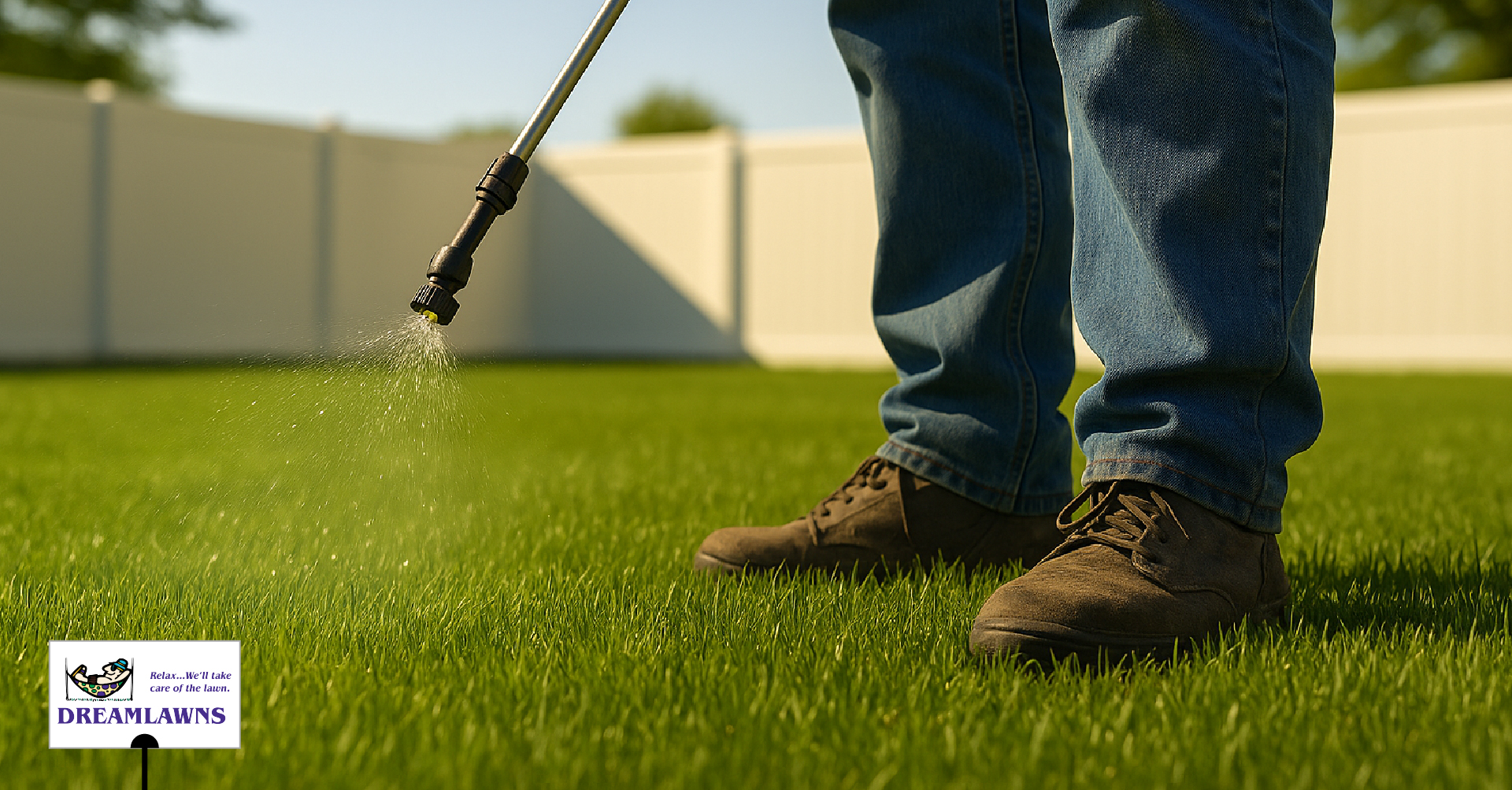
Spring is often seen as a time for new growth and fresh starts, so it’s no surprise that many homeowners assume it’s the perfect season to seed their lawn. The days are longer, the weather is mild, and rainfall is more frequent, conditions that seem ideal for establishing new grass. But for Tall Fescue lawns in Virginia Beach, spring seeding is rarely a good idea.
It’s a counterintuitive truth: despite all the signs pointing to “now’s the time,” seeding your lawn in spring almost always leads to short-term success and long-term failure. Between the looming summer heat, competition from weeds like crabgrass, and a higher risk of disease, spring-seeded lawns often struggle to survive the season, much less thrive.
Let’s break down why spring seeding is a high-risk, low-reward approach, what exceptions exist, and how you can use the spring season to set your lawn up for successful fall seeding instead.
The Problem with Spring Seeding in Virginia Beach
On paper, spring seems like the perfect time to seed a lawn, cool nights, moderate rainfall, and warming soil. But in Virginia Beach, the timing of spring seeding doesn’t align with the biological needs of Fescue. This cool-season grass needs time to develop strong roots and carbohydrate reserves to survive the intense stress of summer. Unfortunately, spring seedlings simply don’t get enough of that time.
Fescue Doesn’t Have Time to Mature
When you seed in spring, you’re giving Fescue maybe 6–10 weeks of mild growing conditions before the temperature begins to climb. That’s not enough time for new grass to develop the deep root system and energy reserves needed to withstand heat, humidity, drought, and disease.
The Virginia Tech Extension notes that even the best efforts in spring usually result in turf that doesn’t survive the summer. If you seed in March, you’re likely watching those seedlings die by June.
New Seedlings Are Extremely Vulnerable
Young grass is more susceptible to:
- Fungal disease, which thrives in the mild, wet conditions of spring
- Drought stress, especially once watering schedules taper off
- Heat exhaustion, once air and soil temps start climbing
- Competition, from both established turf and aggressive spring weeds
This combination of environmental pressure and immaturity makes spring-seeded lawns a short-term fix at best, and an expensive disappointment at worst.
Thin Turf Invites Bigger Problems
If your spring seeding fails, you’re not just back to square one, you’ve actually created a more vulnerable lawn. Thin or patchy turf left behind becomes a perfect environment for crabgrass, broadleaf weeds, and opportunistic grasses like Poa annua and Poa trivialis to take root.
Spring seeding may feel like you’re “doing something,” but without the time and conditions for real establishment, it usually leads to weaker turf and more frustration down the line.
Skipping Pre-Emergent = Welcoming Crabgrass
One of the most damaging consequences of spring seeding isn’t what you’re adding, it’s what you have to skip. To successfully seed your lawn in spring, you have to forego one of the most important weed control tools available: pre-emergent herbicide.
Why Pre-Emergent Matters in Spring
Pre-emergent applications are your best defense against crabgrass, an aggressive, summer-spreading weed that thrives in the same thin, stressed environments where new Fescue struggles. In Virginia Beach, crabgrass begins germinating when soil temperatures hit 55°F for several consecutive days, often as early as mid-March.
Applying a pre-emergent herbicide in late winter or early spring creates a barrier that stops crabgrass and other annual weeds before they emerge. But here’s the catch: that same barrier also stops your Fescue seed from germinating.
Pre-Emergent + Seeding = No Seed Germination
If you try to seed and apply pre-emergent at the same time, neither will be effective. The herbicide will prevent your grass seed from taking root, and skipping pre-emergent leaves your new lawn wide open for crabgrass and other invasive weeds to move in.
And because new grass grows more slowly than crabgrass, those weeds will outcompete your seedlings, often erasing all your hard work within a matter of weeks.
It’s a Lose-Lose Tradeoff
Choosing to seed in spring means sacrificing your most effective weed control option during one of the most vulnerable phases of your lawn’s growth.
Instead of trying to do both and succeeding at neither, it’s better to focus your spring efforts on strengthening your existing lawn and waiting until fall, when seeding and pre-emergent schedules don’t conflict.
Watering Requirements + Increased Disease Risk
Another major drawback of spring seeding is the watering regimen required for successful germination and the chain reaction it can trigger. Fescue seed must be kept consistently moist until it germinates, which typically means watering 2–3 times per day for at least two to three weeks.
While that level of watering is necessary for young grass to sprout, it creates the perfect storm for early-season fungal diseases, especially in the mild, humid climate of Virginia Beach.
Frequent Watering Fuels Disease
Brown patch and gray leaf spot are two of the most common and destructive lawn diseases in our region. These fungal infections thrive in moist conditions and tend to appear as early as April or May when warm days combine with high humidity and overnight dampness. By watering shallowly and frequently (as spring seeding requires), you’re:
- Increasing leaf and soil moisture
- Creating the ideal microclimate for fungus to grow
- Weakening seedlings before they’ve had a chance to establish
And once disease takes hold, it spreads quickly, often wiping out large portions of your young lawn before summer even begins.
Young Seedlings Can’t Fight Back
Established turf may recover from minor fungal outbreaks with some support. Seedlings, on the other hand, don’t have the energy reserves or root depth to bounce back. Fungal stress during establishment almost always means patchy germination, stunted growth, or complete failure.
So instead of creating a lush spring lawn, overwatering and disease create more bare spots, more weed pressure, and more frustration, all while wasting time and money.
The Exception to the Rule
Despite all the reasons to avoid spring seeding, there is one narrow exception where it may be justifiable: when your property has bare, erosion-prone soil with no turf cover at all.
When Erosion Is the Bigger Threat
If you have areas of your yard where soil is exposed and vulnerable to erosion from wind or rainfall, such as sloped yards, new construction sites, or damaged patches from recent grading, some level of spring seeding may be necessary to stabilize the ground and prevent soil loss.
In these cases, seeding isn’t about building a permanent lawn. It’s about creating temporary ground cover to hold the soil in place until fall, when more favorable conditions make long-term turf establishment possible.
Spring Seeding as a Bridge, Not a Strategy
Even in erosion control scenarios, it’s important to treat spring seeding as a short-term solution:
- You should still plan to reseed in fall for lasting turf development
- You’ll need to forego pre-emergent weed control in the seeded areas
- You’ll still face a higher risk of disease and heat stress in summer
In other words, spring seeding can help buy time, but it won’t replace a proper fall seeding plan. If you’re seeding in spring due to bare soil, the goal should be simple: get some coverage, manage expectations, and prepare to do it right in fall.
What to Do Instead
If you’re tempted to seed your lawn in spring, take a step back and consider a more effective long-term strategy. Instead of planting seed that’s unlikely to survive summer, use the spring season to prepare your lawn for a highly successful fall seeding, when conditions truly support Fescue development.
Use Spring to Build Lawn Strength and Soil Health
Rather than focusing on new seedlings, spring is the time to:
- Apply pre-emergent herbicides to stop crabgrass before it takes hold
- Fertilize appropriately to feed your existing turf and build density
- Monitor and treat fungal disease before it spreads
- Address pest pressure like grubs or armyworms, which weaken turf and open the door for invasive weeds
- Improve soil structure through aeration, pH adjustment, or organic amendments
These steps create an environment where your existing turf thrives and your future seed has the best possible conditions for success.
Plan Now for Fall Seeding Success
Fall offers the ideal combination of cooler temperatures, less competition from weeds, and lower disease pressure. By seeding in late summer to early fall, you give your new grass months to establish before facing summer heat.
To make the most of your fall seeding window:
- Avoid damaging your lawn in spring or summer with unnecessary seeding or watering practices
- Stick to clean, certified seed blends that are free from contaminants like Poa annua and Poa trivialis
- Time your overseeding after aeration for improved seed-to-soil contact
- Follow proper post-seeding care, especially consistent watering through germination
A little patience now pays off big in the fall, when your seeding efforts are actually positioned to succeed.
How Dreamlawns Can Help
At Dreamlawns, we take a practical, honest, and results-driven approach to lawn care. That’s why we don’t recommend spring seeding for Fescue lawns. Not because we don’t want to help, but because we know from experience and research that it simply doesn’t work.
Fall-First Seeding Strategies Built for Success
We focus on what works, and for Fescue, that means planning and executing a fall seeding program tailored to your property. Here’s how we do it:
- Comprehensive property assessments to identify weak spots, soil issues, and turf density
- Aeration and overseeding in early fall, when cooler temperatures and lower disease pressure support long-term establishment
- Use of clean, certified seed blends, like Aqua Maxx, free of Poa annua and Poa trivialis contamination
- Custom guidance for post-seeding care, including watering schedules and disease prevention
Work With Dreamlawns
Seeding your lawn in spring may seem like a good idea, but it’s almost always a costly mistake. Between the short growing window, skipped weed control, increased disease risk, and the unforgiving summer that follows, spring seeding sets you up for disappointment more often than success.
Instead, focus on what will make a difference: strengthening your existing turf, protecting it from pests and disease, improving soil conditions, and laying the groundwork for a proper fall seeding, when Fescue actually has the chance to thrive.
At Dreamlawns, we’ll help you build a lawn care strategy that works with nature, not against it. Whether you need expert fertilization, weed prevention, or a fall-first seeding plan, our team is here to give you honest guidance and proven results.
Contact us today to schedule a consultation and take the first step toward a healthier, more resilient lawn.
Dreamlawns provides superior lawn care service to Virginia Beach & Chesapeake VA residents.




